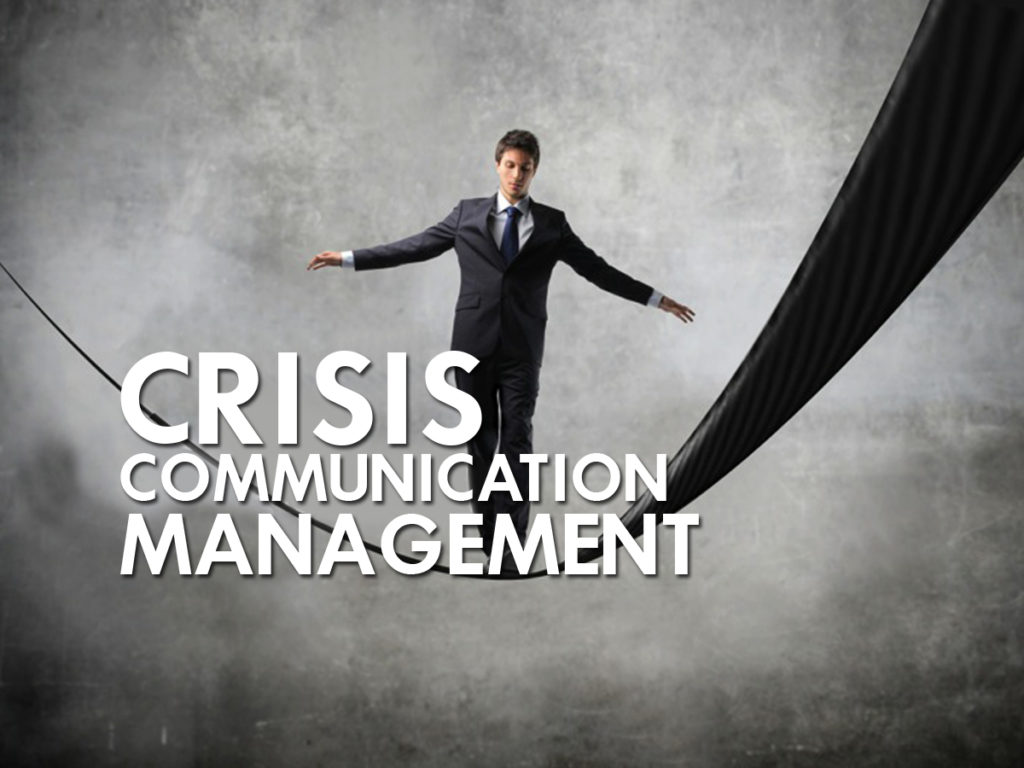
Crisis Management
Crisis Communication Messages
All companies should be prepared to handle crises – unforeseen disruptions to business operations that involved threats to public safety, major financial loss, and reputation loss. Although companies cannot foresee crises precisely, they should operate under the assumption that crises will occur – that is, it’s not a matter of if, but when. To minimize and correct damage to victims and avoid excessive reputation loss, companies should excel at all stages of crisis management.
To minimize and correct damage to victims and avoid excessive reputation loss, companies should excel at all stages of crisis management: pre-crisis planning, crisis responses, and post-crisis actions (as depicted in Figure BC.1).

Another key component of preparation is developing a crisis communication plan. The plan should address how the company will inform each group of stakeholders about crisis events (see Figure BC.2).

Applying the AIM Planning Process for Crisis Communications
The planning process for crisis communications must be thorough but compressed. Providing victims and other stakeholders with timely and accurate information to avoid further loss is next to impossible without a designated communication plan as part of a larger, regularly updated crisis response plan. With such a plan in place, a crisis communication team can act swiftly to help its stakeholders avoid further losses and help the company restore its credibility.
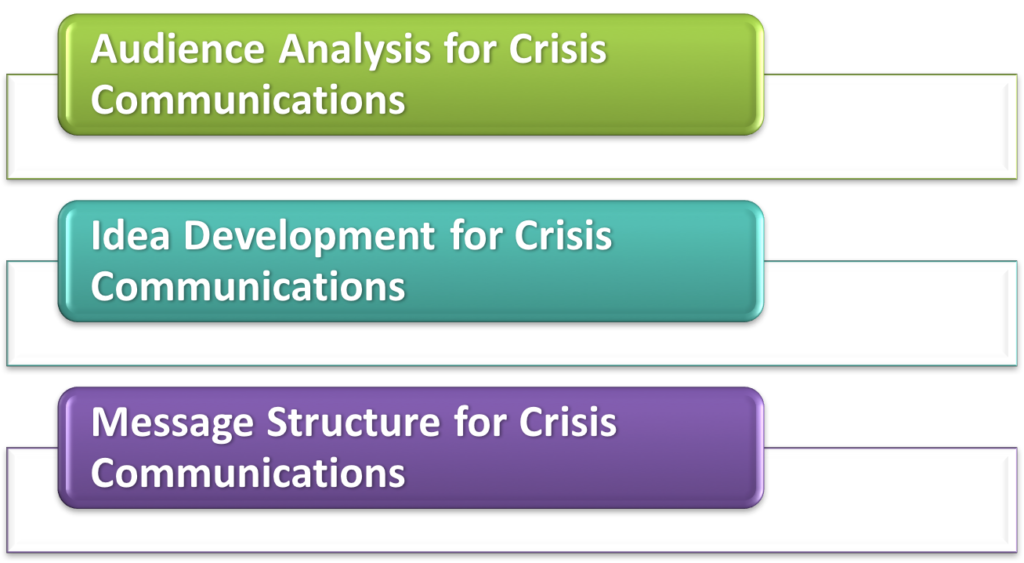
- Audience Analysis for Crisis Communications Crisis messages should be designed with particular stakeholders in mind. Typically, crisis communication teams determine those stakeholders who are most affected and make contact with them as soon as possible. Often crisis communication teams focus on external stakeholders and fail to provide employees with enough information. Yet, for 80 to 85 percent of crisis situations, employees are the first or second most important stakeholders.
- Idea Development for Crisis Communications Although companies should provide crisis information as soon as possible, they must provide accurate information. The crisis communication team must rapidly assemble the facts, put meaning to the information they collect, and take positions about the best ways for stakeholders to protect themselves.
- Message Structure for Crisis Communications The primary purpose of crisis communications is to help victims and other stakeholders. A secondary purpose is to avoid or repair reputation loss.
Types of Crises and Levels of Company Responsibility
Crises can be broadly classified into three types: victim crises, accident crises, and preventable crises (see Table BC.1).

Audience Analysis for Crisis Communications
Crisis communication teams should focus not only on what information to provide but also on how they can show empathy. The success of many crisis messages hinges on the recipients’ emotional reactions to them. In many cases, customers, employees, and other stakeholders are willing to forgive companies if they provide timely and accurate information and make good-faith, caring efforts to improve the situation. Many of these judgments about whether the response is in good faith or sincere or caring are made quickly. Thus, the crisis communication team should develop and deliver crisis communications under the assumption that they must gain trust and emotional commitment from various stakeholders rapidly.
Idea Development for Crisis Communications
Crises can be broadly classified into three types: victim crises, accident crises, and preventable crises (see Table BC.1). In a victim crisis, stakeholders generally do not hold companies responsible. For example, an earthquake may affect the operations of a company and the safety of its employees, yet stakeholders will not believe the company is at fault. In an accident crisis, stakeholders hold companies responsible but understand that what happened was not intentional and was difficult to foresee. For example, a workplace accident due to equipment failure would typically be considered unintentional, but stakeholders would still assign some responsibility to the company. In a preventable crisis, stakeholders believe the company is to blame and is completely responsible for the damages and losses to stakeholders. Typically, if company employees are found to be at fault for the crisis, stakeholders assign complete responsibility to the company.
Message Structure for Crisis Communications
The components of crisis communication are:
- Express concern.
- Explain corrective actions.
- Provide instructions.
- Give an excuse or provide justification (for certain types of crises).
- Issue an apology and explain compensation (for certain types of crises).
Creating Responses in Crisis Communication
The primary purpose of crisis communications is to help victims and other stakeholders. A secondary purpose is to avoid or repair reputation loss. You can use various types of statements as depicted in Table BC.2 and described in this section to develop appropriate crisis messages.
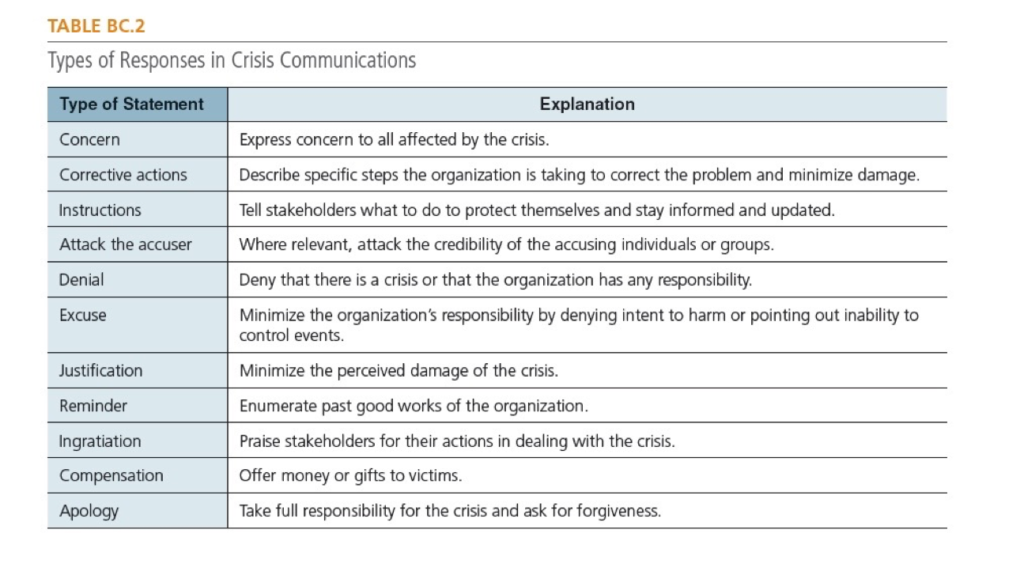
Once crisis communication teams have planned their messages, they must act under significant time pressures to compose them. They must also act quickly to modify them for various media: letters, emails, web pages, blogs, texts, radio and television broadcasts, and so on. Members of crisis communication teams should work closely to ensure that they develop consistent messages.
When your company is under attack, consider the following principles:
- Gather the facts.
- Avoid heavy-handedness (show of force).
- Respond quickly.
- Use the appropriate channels.
- Rely on external advocates.
- Respond with credentials.
Reviewing Crisis Messages
During the crisis response stage, you will likely be pressed for time. In these tense moments, rereading your written crisis communications is essential. Pay special attention to accuracy. In some crises, your stakeholders’ physical and financial security are at stake. Also, if possible, consider having your legal counsel read your messages before you distribute them.
As with other communications, ask yourself and discuss with others whether your crisis messages are fair. Ask questions such as those listed in Figure BC.8 to ensure you are communicating in the interests of others.
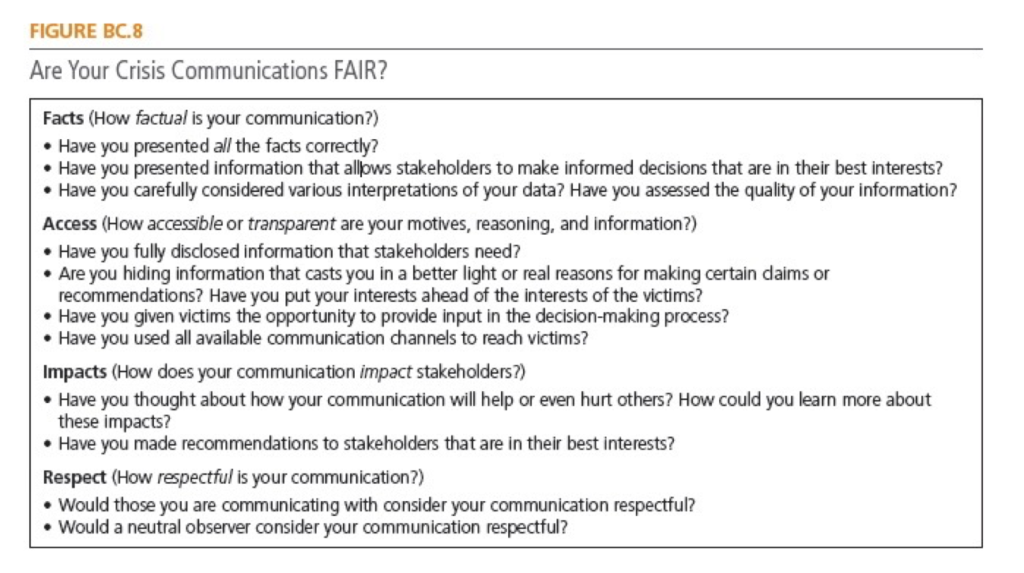
The Role of Public Relations Today
In the emerging Social Age, companies are less able to generate predictable media exposure due to the shrinking options in mass advertising (especially in television), the increasingly fragmented media landscape (people turning to many sources and media for information), and the growing importance of online consumer reviews and activist blogs. Since so many consumers rely on social media for information, the public relations (PR) field is among the business areas most rapidly adopting Social Age practices. Still, the success of these PR messages is far more difficult to control and measure than just a decade ago.
Corporate reputation is “an intangible asset that allows the company to better manage the expectations and needs of its various stakeholders, creating differentiation and barriers vis-à-vis its competitors” (Elliot Schreiber).
Principles for PR Communications
- Develop Credible Relationships Public relations can be viewed as an unending process of building and nurturing relationships with stakeholders.
- Build a Brand or Strategic Promotion One primary goal as you build relationships with stakeholders should be to differentiate your company’s brand, products, and services from those of competitors.
- Complete the Campaign Cycle A strategic approach to public relations involves campaigns – a series of methodical activities over a certain time period to meet defined PR objectives.
- Communicate the Good the Company Does for Stakeholders Companies should regularly and honestly publicize stories and articles about the good deeds they do. Informing stakeholders about the economic and social value the company provides enhances its reputation.
- Transition from Information Age PR to Social Age PR The transition to truly networked communication will take decades. Some business functions have been quicker to adopt social media. Public relations is among the business functions that has done so the most rapidly.
Develop Credible Relationships
A company builds credibility in its relationships to the degree that it achieves three types of responsibility: economic responsibility (similar to competence), ethical responsibility (similar to character), and social responsibility (similar to caring). Economic responsibility means producing products and services that meet the needs of customers and clients; ethical responsibility means that corporate activities comply with high ethical and legal standards. Social responsibility means that companies give back, serve, and meet the social interests of their communities.
Build a Brand or Strategic Promotion
One primary goal as you build relationships with stakeholders should be to differentiate your company’s brand, products, and services from those of competitors. In other words, the goal is not just to gain positive public exposure. Rather, it is to carve out a distinctive corporate reputation for delivering value that is superior to that of competitors.
Complete the Campaign Cycle
A strategic approach to public relations involves campaigns – a series of methodical activities over a certain time period to meet defined PR objectives. At the heart of PR campaigns is a listening and research approach. Listening to stakeholders and applying a research approach at each stage in a campaign cycle ensures that PR activities create the most value for a company and its stakeholders.
Transition from Information Age PR to Social Age PR
In Social Age PR, business professionals can circumvent the traditional media and use communication channels that more quickly reach stakeholders. In this social media environment, PR professionals will increasingly give stakeholders the opportunity to talk back. However, using social media for PR has several disadvantages: Most people think social media messages are less reliable than messages in traditional media outlets and print. Also, controlling the message is more difficult because of the fragmented, two-way nature of the social media environment.
Most medium and large organizations have created social media teams that handle public relations. These teams (1) develop formal social media policies; (2) monitor internal and external communities; (3) engage online communities with fan pages, corporate blogs, online innovation forums, and meetings with prominent bloggers; and (4) act as first responders by acknowledging mistakes and warding off crises when negative, brand-threatening social media activity occurs.
While your PR strategy will stay the same, you will modify your PR messages to reflect the norms and values generally associated with Information Age versus Social Age communication tools. As shown in Table BC.5, the tone of Information Age communication tools, such as e-newsletters and online newsrooms, is generally more formal, professional, authoritative, and well crafted. By contrast, the tone of Social Age communication tools is typically less formal (but rarely informal), more authentic, and more spontaneous.
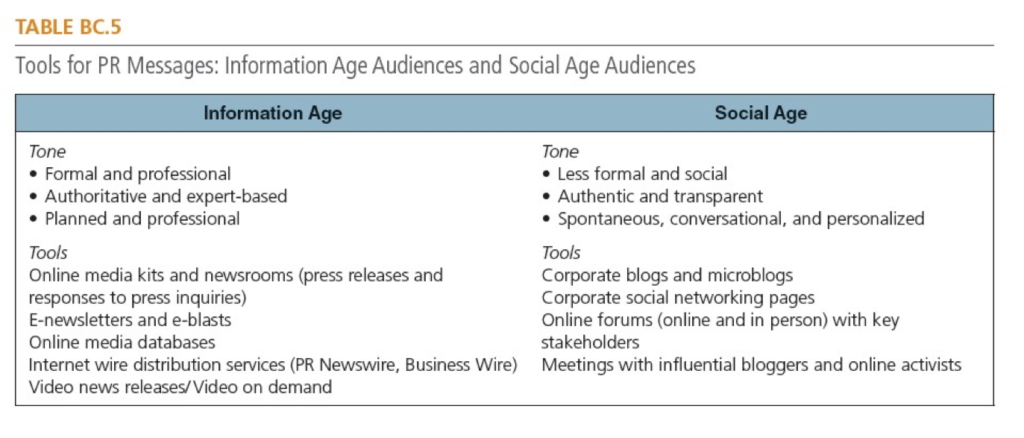
As you develop PR messages, answer questions such as the following about each stakeholder group:
- How much do they know about your company? How positively or negatively do they view it?
- What is their view of your brand value? Are they satisfied with your performance in the following areas: economic responsibility, social responsibility, and ethical responsibility?
- From what sources do they get information about you and your competitors?
- Through which communication channels can you best reach them?
Matching Influence Techniques to Public Relations Efforts
To make your PR efforts most effective, find ways to influence stakeholders so that they view your company’s distinctive brand favorably and so that they are more likely to support your company through positive word of mouth and purchases. Robert Cialdini’s influence techniques (described in Chapter 10) are useful in shaping stakeholders’ views through PR messages. See Table BC.6 for various strategies Better Horizons uses in PR efforts and messages to influence stakeholders.

Message Structure for PR Messages
In the press release style, which still accounts for most written PR messages, the main components include a headline, a dateline, the story, a boilerplate, and contact information.

Creating PR Messages
Once you have planned your message, you are ready to write it with a focus on achieving excellence in tone, style, and design. Because most stakeholders will make rapid judgments and be skeptical of your motives and interests, you want a friendly tone. Also, use words, phrases, and sentences that help you achieve transparency and objectivity. Stakeholders realize that the message contains your version of reality, and they may perceive your version as skewed toward your own interests rather than theirs. If you can convince your audience members that you are writing objectively and in their interests, you will encounter far less resistance.
As with other communications, ask yourself and discuss with others whether your PR message is fair to others. Ask questions such as those listed in Figure BC.16 to ensure you are communicating in the interests of others.
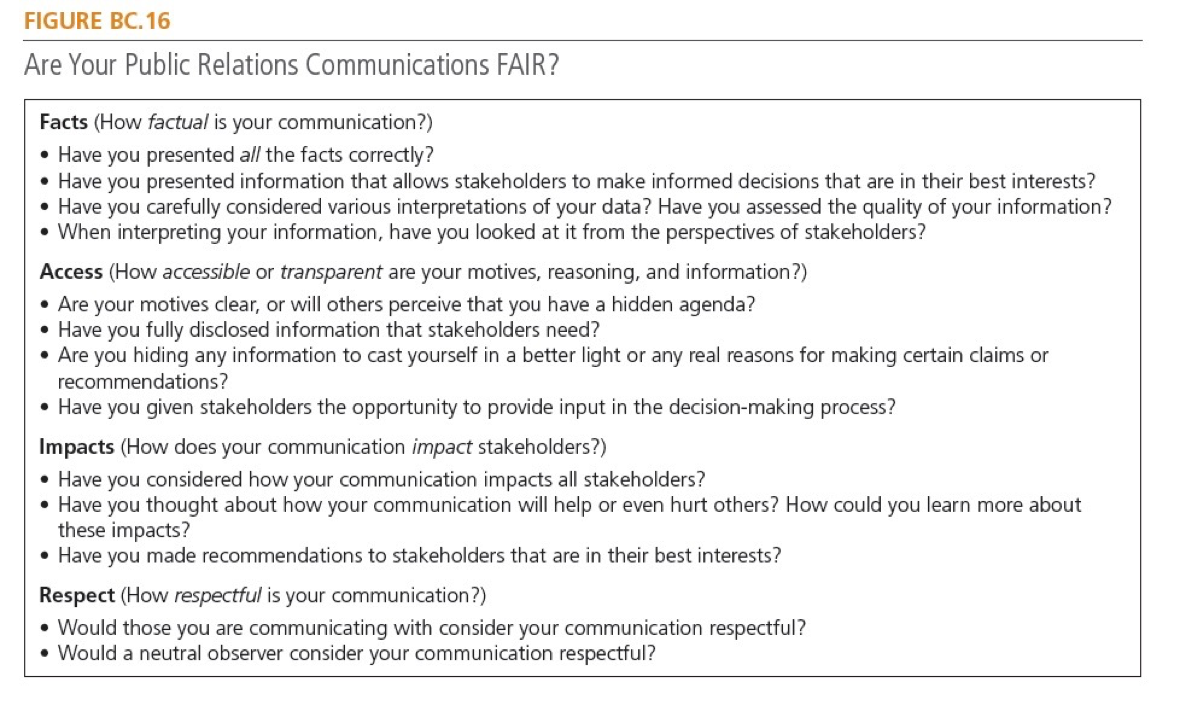
Source: Based on Cardon, P.W. (2016). Crisis Communication and Public Relations Messages (Bonus Chapter). In Business Communication. McGraw Hill Education.



